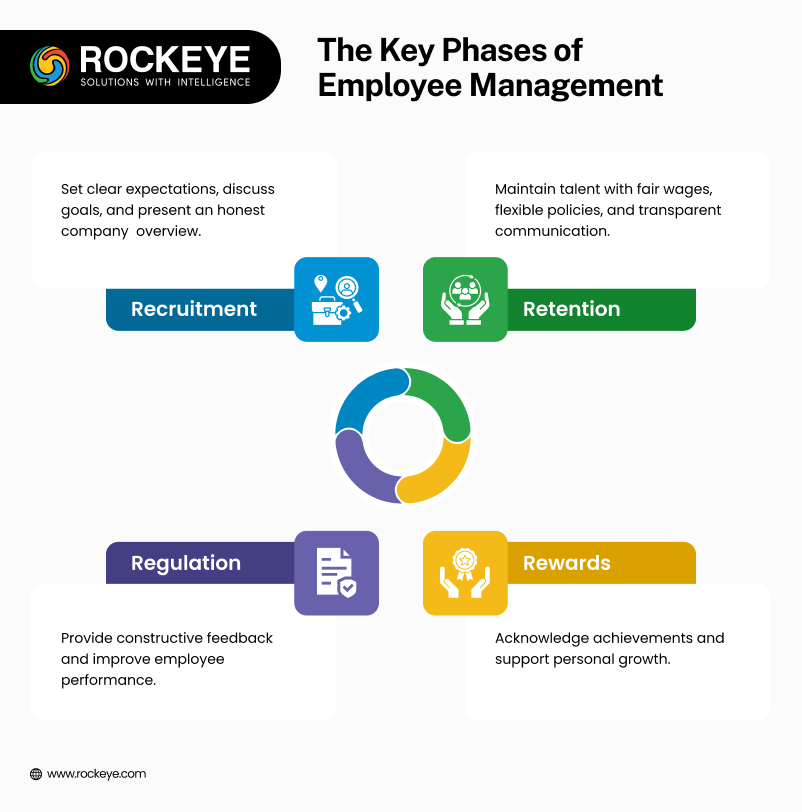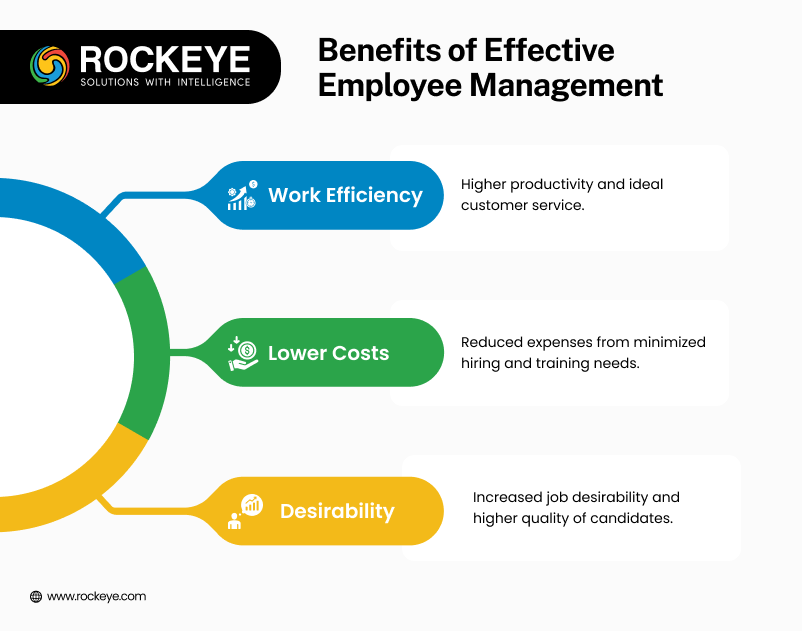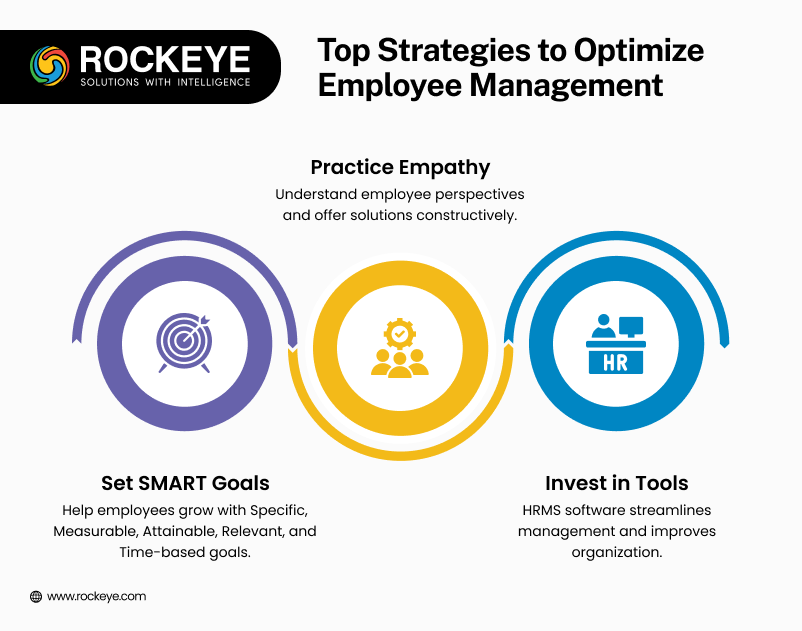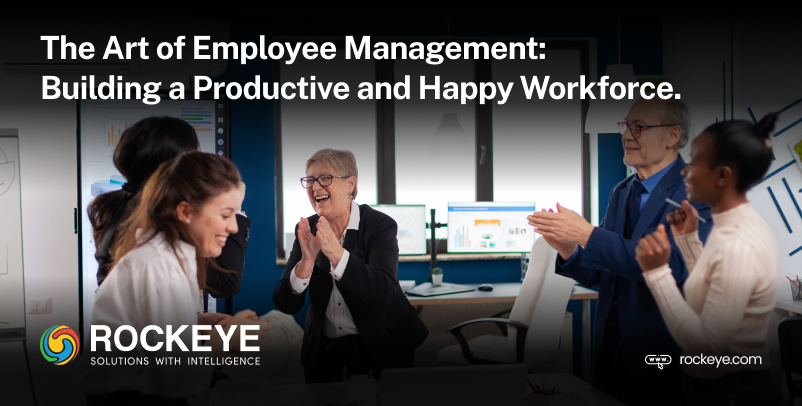Since employee management is the guiding factor of an organization’s success, it’s important for leaders to have the right skills and tools in place to manage their team effectively.
If you’re a leader looking for ways to implement best practices into your employee management and attendance monitoring system, this article is for you.
What Is Employee Management?
Simply put, employee management helps employees perform their tasks well while also enjoying the work they do and achieving the company’s overall goals.
Effective employee management should mutually benefit the company, its employees, and the community they serve.
How this management functions is often structured by an organization’s human resources department and can be broken down into a few critical categories. Ultimately, this keeps employees excited about their job and helps operations run smoothly.
Let’s take a look at the different aspects of employee management.

Recruitment
Employee management begins before an employee even starts a new role. In fact, during the recruitment process, expectations are already being set by the manager and hiring team.
It’s important to:
- Create a clear, concise job description
- Manage company expectations
- Gauge applicant interest
- Discuss the applicant’s personal and professional goals
- Ask about their history with managing constructive criticism
- Explain the company’s mission
- Be honest with the applicant about the position
The last point is often overlooked but is perhaps the most important. The recruitment process is only truly successful if the hiring manager is honest from the start.
You want to hire an ideal candidate as much as a potential candidate wants to work for a terrific company. Even if unintentional, this pressure to impress can create an impulse to leave out key information or exaggerate aspects of your company to make a good impression.
Being honest does not mean revealing company secrets or sharing every negative thing that has ever happened at the office, but the candidate should leave their interview with an understanding of the company’s goals, work habits, culture, and even potential pay.
When this setting of expectations is done right, some highly qualified applicants might not receive the job. And even if they are offered the job, with an honest assessment of the position, an ideal candidate might turn the offer down.
So, what’s the ultimate goal of the recruiting process? To hire the right person for the job who has been set up for success — their own and your company’s.
Retention
Once you have the perfect candidates to fill each position, the next step is to keep employees engaged and prevent unnecessary turnover.
There are varying reasons an employee might leave a position at a company. Some individuals retire or relocate within the business, while others leave due to disagreements or poor conditions.
These are two extremely different considerations, but they both point to one thing: retention. Especially in the face of today’s Great Resignation, businesses are structuring their company policies around retention.
Here are some tips to ensure your company is doing everything it can to maintain talent:
- Offer livable wages and an optimized benefits package
- Allow for flexibility and for employees’ opinions to be heard
- Communicate transparently and regularly
- Include technology upgrades in budget plans
- Always show appreciation for a job well done
A significant part of employee management is not only to create a way for employees to share their thoughts or concerns, but to also make sure they won’t feel criticized or uncomfortable doing so.
When employees voice their thoughts, hearing them out and implementing change wherever possible provides a workspace where they feel valued.
Pro Tip: Achieve this goal by providing multiple communication channels through services like ROCKEYE HRMS.
Regulation
Regulation can seem harsh, but it’s an important part of an organization’s success.
While regulation does not mean that employees should be micromanaged, it does imply that conversations regarding poor-quality performance should be had when necessary.
When having these conversations, strive to give constructive criticism to improve an employee’s performance instead of just listing a person’s weaknesses.
Receiving constructive feedback allows employees to constantly improve their skills, while straight criticism leads to frustration and higher turnover rates.
When offering feedback, be sure to follow the tips below:
- Confirm professional strengths before addressing any concerns
- Only address what has been observed, not what has been speculated
- Only address what can be changed
- Come prepared with strategies for improvement
- Allow for open communication and responses
- Summarize feedback and strategies and reaffirm their importance to the company
Additionally, avoid making statements that suggest the employee is inherently wrong or that the company has “a certain way of doing things.” This leads employees to believe that their work is not valued and that any negative aspects of the organization will remain unchanged.
Rewards
Rewarding employees is an effective way to congratulate them on a job well done and to promote productivity. There are several reasons that you might reward either an individual or the entire staff, and there are nearly unlimited ways to do so.
Whether it’s for a promotion or overall improvement, some great ways to show recognition include:
- Verbal recognition during a meeting
- A note signed by the entire staff
- An extra day of vacation
- A company wellness day
- Lunch paid for by the company
The idea of “rewards” can also be expanded beyond a congratulatory effort, too. Offering support for an employee during a difficult time can make a significant impact as well.
However you choose to show your employees you care, choose ways that are sustainable long-term, and treat employees of all ranks fairly.
The Importance Of Employee Management

Following the practical tips within these categories of employee management goes beyond creating happier, more skilled employees and achieving company goals.
Implementing these best practices also helps improve the bottom line through productivity, minimized expenses, and a higher level of company desirability. Let’s take a look at these benefits in more detail.
Work Efficiency
It’s no secret that employees who feel appreciated by their company and believe their work is meaningful tend to be more productive. And higher productivity levels lead to a more efficient organization, allowing everyone involved to benefit.
This also shows in the company’s final product. Regardless of whether the end goal is to create a physical commodity or offer other forms of service, the right combination of effective job management and happy employees leads to ideal customer service.
Lower Costs
Countless costs go into operations management, and the new-hire process is no exception. The staff energy that goes into creating the perfect description of an open position and going through multiple interviews with numerous candidates is a considerable expense.
Depending on the size of the company, orientation can also be a long but necessary process that requires employees to spend time away from projects. When turnover is high and employees are regularly being hired, this can become very expensive very quickly.
This is why effective employee management is important: It reduces the amount of time and money your staff spends on recruiting and onboarding new workers.
Desirability
The most sought-after jobs are not necessarily the ones that pay the most or offer the best benefits. Oftentimes, employees simply want to be treated well and rewarded for quality work.
When your company has a low turnover rate and a good work-life balance, this increases the organization’s desirability. When an opening becomes available, this often results in a higher volume of candidates and a greater selection of qualified individuals for the job.
How To Effectively Manage Employees

Set Goals
A great way to help employees strengthen their skillset and grow as professionals is by creating a set of goals to be accomplished throughout the year.
Following a “SMART” checklist when setting goals helps everyone manage expectations. The acronym provides particular criteria when developing objectives and stands for goals that are:
- Specific
- Measurable
- Attainable
- Relevant
- Time-based
One way to accomplish set goals is to implement a quarterly checklist for employees to define their annual objectives and stay on track.
In addition, scheduling meetings with employees every once in a while to discuss their goals and their progress will further uncover any setbacks, successes, or necessary changes.
Practice Empathy
No employee enjoys being told they need to improve, but leaving them in the dark does not benefit anyone.
Practicing empathy can promote growth while being mindful of emotions. To do this, strive to understand the situation through your employee’s perspective and approach it lightly while highlighting their strengths and providing solutions to address any weaknesses.
Invest In The Right Tools
Even if you follow every last piece of advice listed above, practicing employee management in the right way can be stressful and require extreme organizational skills.
HRMS software, like ROCKEYE, takes the stress out of managing while increasing efficiency, lowering costs, and developing an overall better work environment. The software assists in planning, reporting, and tracking the everyday elements of your company.
Employee Management Made Easy
Employee management has the potential to either build an exceptional organization or create unhappy workers and costly mistakes. Every step that a company takes toward proper employee growth and development is another step toward overall success.
Through Rockeye we offer endless ways for you to achieve ideal employee management, making Rockeye perfect for any industry looking to retain talent and increase profits.
Whether you’re communicating a new set of goals with an employee or organizing the tasks of every worker, Rockeye takes the stress out of a complicated process. Now, it’s easier than ever to manage employees in a way that’s effective and beneficial for everyone.
To discover more free resources to help you manage your business better, organize and schedule your team, and track and calculate labor costs, try ROCKEYE today.

FAQs
What is employee management?
Employee management encompasses practices and strategies that empower employees to excel in their roles while fostering job satisfaction and contributing to the company’s overarching objectives. It’s a multifaceted approach that benefits the company, its workforce, and the community it serves. The human resources department often plays a crucial role in structuring and implementing these management functions.
Why is honesty crucial during the recruitment process?
Transparency during recruitment ensures that potential candidates gain a realistic understanding of the company’s culture, work environment, and expectations. This helps attract candidates who align well with the company’s values and reduces the likelihood of mismatches and subsequent turnover. While honesty is important, this doesn’t mean divulging confidential information or dwelling on negative experiences; it’s about providing a balanced and truthful picture.
How can companies enhance employee retention?
In today’s job market, companies face the challenge of retaining skilled employees.5 Strategies to mitigate turnover include offering competitive wages and benefits packages, fostering a flexible and inclusive work environment where employees feel heard, maintaining transparent communication, investing in technology upgrades, and consistently recognizing and appreciating employee contributions. It’s also important to create channels for employees to voice their concerns without fear of criticism.
What are the benefits of providing constructive criticism instead of direct criticism?
Constructive criticism, unlike blunt critiques, focuses on improvement and professional development. By highlighting strengths and offering solutions alongside addressing weaknesses, it empowers employees to enhance their skills. This approach fosters a positive work environment where employees feel valued and motivated to grow, ultimately contributing to higher retention rates.7 Conversely, direct criticism can lead to frustration and dissatisfaction.
What are some effective methods for rewarding employees?
Recognizing and rewarding employees for their achievements boosts morale and productivity.8 Rewards don’t always have to be grand gestures; they can range from verbal appreciation during meetings to small tokens of gratitude like a handwritten note from colleagues or a company-sponsored lunch. Other options include additional vacation days or organizing wellness activities. The key is to choose rewards that are sustainable, equitable across all employee levels, and genuinely appreciated.
- business growth
- constructive feedback
- employee engagement
- employee management
- employee onboarding
- employee retention strategies
- employee rewards
- employee satisfaction
- HR best practices
- HR tools
- human resources
- management tools
- productivity
- recruitment strategies
- retention
- ROCKEYE HRMS
- team management
- workplace culture
- workplace efficiency

